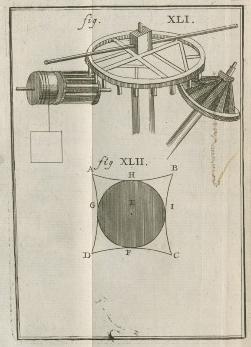The project deals with the transformation of antique concepts in mathematics, mechanics, and the theory of heat after the rise of classical physics in the seventeenth and eighteenth centuries. Focusing on the time between the scientific and industrial revolutions, the project analyzes the relation between the idea of a revival of antique forms of knowledge and the idea that antique traditions are no longer relevant for a modern epoch that is characterized by radical innovations in knowledge, methods, resources, and institutions. It is assumed that this transformation affected both the worldview in general (through subsequent revisions of mechanical natural philosophy) and practical mechanical knowledge (especially in the use of resources).
In the first phase of CRC 644 (2005–2008), the research group at the Max Planck Institute for the History of Science investigated structural changes in antique knowledge due to its historical transfer, focusing on central mechanical terms as weight, motion, and force. In the second phase of the project (2009–2012) the main focus was put on the connection between practical and theoretical knowledge in mechanics, architecture, and astronomy from antiquity up to the Renaissance. Based on the insights of the previous phases, the research of the final phase (2013–2016) investigated if and to what extent antique natural science continued to have an impact after the seventeenth century, despite the rise of a new approach that explicitly contradicted the antique tradition.
The central research questions were: 1) If and to what extent did classical physics and analytical mechanics supersede the auctoritas of antique knowledge of nature? 2) If and to what extent did antique practical and technical knowledge, as well as antique models of thought, survive after mathematical physics and the new concept of science based on it replaced the traditional philosophical foundations of physics?
These questions are addressed in two sub-projects: One of the projects dealt with the analytical turn in physics in which computability increasingly replaced intuition as argumentative strategy. The second project investigated the use of energy-rich resources in the interplay of the development of scientific knowledge and socio-economic dynamics. Both interconnected projects reflected on innovations of the eighteenth century and analyzed the extent to which the development of mechanics starting in the seventeenth century can be understood as a “second order transformation” (a transformation of the transformation of antiquity).
Sub-project 1 (Christoph Lehner): Changes in physical terminology as epistemological transformations: From intuitiveness to post-metaphysical computability.
Sub-project 1 focused on the transformation of the conceptual structure in the mechanics of Newton and the analytical mechanics of his successors until the end of the eighteenth century. The development of analytical mechanics was characterized by a shift from Aristotelian and scholastic arguments to a mathematical representation based on analytical geometry and infinitesimal calculus. The project investigated the reinterpretation of traditional terms such as force, motion, and space caused by the introduction of new mathematical methods and the role of antique traditions in this transformation. One central research question asked if key technologies and their challenges played an important role in this transformation, just as in the developments of the early modern era studied in the previous phases of the project. A second research question asked which repercussions this analytical turn had on the worldview of cosmology, metaphysics, and epistemology.
Sub-project 2 (Helge Wendt): Transformation of scientific practice and science organization in resource knowledge and resource use in the long eighteenth century.
This research project examined the transitional period between the Scientific and Industrial Revolutions, in continuation of the research into the transformation of the relation between practical and theoretical knowledge in the example of Renaissance pneumatics (studied in the previous two project phases). Employing the example of knowledge and use of energy-rich resources, it studies the processes of change in the closely interrelated fields of science, technology, and social and economic organization. The concentration is on theoretical and technological transformation processes of resources such as wind, water, wood, and coal, which became the subject of description and analysis for scientists, engineers, and technically competent entrepreneurs. The goal of this research project was to provide a comprehensive study of the “End of Antiquity” by combining different areas of historical research such as social, economic, and cultural history, as well as the history of science.

